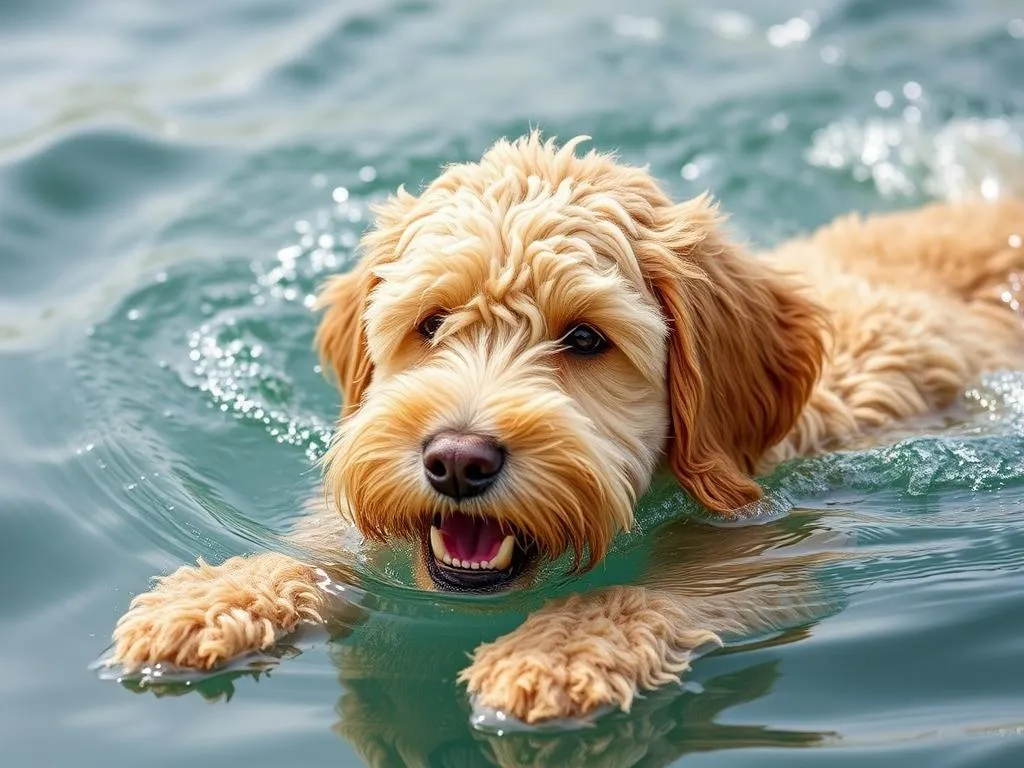
Introduction
Dog health care is an essential aspect of responsible pet ownership, and understanding the physical activities that benefit our furry friends is crucial. Labradoodles, a popular hybrid breed, are known for their friendly temperament and intelligence, making them great companions. As they are often active and playful, swimming can be a fantastic activity for Labradoodles, providing both physical exercise and mental stimulation. This article will delve into how well Labradoodles swim, exploring their swimming abilities, health considerations, and the benefits of this enjoyable activity.
Understanding Labradoodles
Breed Characteristics
Labradoodles are a cross between Labrador Retrievers and Poodles, resulting in a variety of sizes and coat types. Typically, they range from 15 to 24 inches in height and can weigh between 15 to 65 pounds, depending on whether they are standard, medium, or mini Labradoodles. Their coats can vary from curly to wavy and require regular grooming to prevent matting. Labradoodles are known for their friendly, sociable nature, making them excellent family pets.
In terms of energy levels, Labradoodles are highly active dogs that require regular exercise. Daily walks, playtime, and activities like swimming are essential for their physical and mental well-being. They thrive in environments where they can engage in various physical activities, making swimming an ideal option.
Common Health Issues
Like all breeds, Labradoodles can be prone to specific health issues. Some common genetic predispositions include hip dysplasia, elbow dysplasia, and certain skin conditions. Regular veterinary check-ups are vital to ensure early detection and management of any potential health problems. Keeping your Labradoodle healthy not only prolongs their life but also ensures they can enjoy activities like swimming without any discomfort.
Swimming: A Natural Activity for Dogs
Benefits of Swimming for Dogs
Swimming is a natural and beneficial activity for dogs, including Labradoodles. It offers several advantages:
- Low-impact exercise: Swimming is gentle on the joints, making it an excellent option for dogs of all ages, especially those with joint issues or arthritis.
- Mental stimulation: Water activities can help stimulate a dog’s mind, providing new sensory experiences and opportunities for play.
- Cooling off in hot weather: Swimming is a fantastic way for dogs to cool down during hot summer months, reducing the risk of heat-related illnesses.
Swimming Safety for Dogs
While swimming can be fun, safety should always be a priority. Supervision is crucial; never leave your Labradoodle unattended in or near water. Additionally, it’s essential to recognize signs of distress in dogs while swimming, such as excessive barking, struggling to stay afloat, or fatigue. If you notice these signs, it’s time to intervene.
How Well Can Labradoodles Swim?
Physical Attributes That Aid Swimming
So, how well can Labradoodles swim? Their physical characteristics play a significant role in their swimming capabilities. Labradoodles typically possess a robust body structure, which contributes to buoyancy and stability in the water. Their strong legs provide the propulsion needed for swimming, while their webbed feet can also aid in movement through water.
Their coat type can influence their swimming ability. Labradoodles often have a water-resistant coat, which helps them stay buoyant and dry faster after swimming. However, grooming is essential as matted fur can hinder their swimming performance and lead to discomfort.
Individual Variations
Not all Labradoodles are created equal when it comes to swimming. Individual variations in swimming abilities can be influenced by several factors:
- Age: Younger Labradoodles may be more energetic and eager to swim, while older dogs might be more cautious or experience joint issues that affect their swimming ability.
- Health: Dogs with underlying health issues may struggle with swimming, so it’s essential to consult a veterinarian if you have concerns about your Labradoodle’s health before introducing them to water.
- Experience: Just like people, dogs can be more or less comfortable in water based on their prior experiences. A Labradoodle that has been introduced to water from a young age is likely to be more confident swimmers.
Training Labradoodles to Swim
Training your Labradoodle to swim can be a rewarding experience, and it’s essential to do it correctly. Here are some tips for introducing your dog to water:
- Start Slow: Begin with shallow water where your Labradoodle can walk and gradually get accustomed to the sensation of water.
- Use Positive Reinforcement: Encourage your dog with treats, praise, and toys to build a positive association with swimming.
- Demonstrate: If you’re comfortable, show your Labradoodle how to swim by entering the water yourself. Dogs often follow their owners and feel more secure when they see you enjoying the water.
- Safety Gear: Consider using a canine life jacket, especially for inexperienced swimmers or when swimming in deep water.
Health Considerations for Swimming Labradoodles
Physical Health Benefits
Swimming offers numerous physical health benefits for Labradoodles:
- Cardiovascular fitness: Swimming is an excellent aerobic exercise that helps improve heart health and overall endurance.
- Muscle tone: The resistance of water provides a full-body workout, helping to tone muscles without putting undue stress on joints.
- Weight management: Regular swimming sessions can help maintain a healthy weight, especially important for Labradoodles prone to obesity.
Potential Health Risks
While swimming is generally safe, there are potential health risks to be aware of:
- Ear infections: Labradoodles with floppy ears are more susceptible to ear infections due to moisture accumulation. Dry your dog’s ears after swimming to minimize this risk.
- Water-related illnesses: Dogs can contract illnesses from contaminated water. Avoid letting your Labradoodle swim in stagnant or questionable water sources.
- Hypothermia risks: If swimming in cold water, be cautious of your dog becoming too cold. Monitor them closely and limit swimming time in chilly conditions.
Post-Swimming Care
After swimming, proper care is essential to keep your Labradoodle healthy:
- Drying off: Thoroughly dry your dog, paying special attention to their ears and underbelly. A towel or a dog-specific drying coat can be helpful.
- Grooming tips: Brush your Labradoodle after swimming to remove any debris or tangles caused by water exposure.
- Signs of fatigue: After swimming, watch for signs of fatigue like excessive panting or reluctance to play. If your dog appears overly tired, allow them to rest and recover.
Conclusion
Swimming can be a delightful and beneficial activity for Labradoodles, contributing significantly to their overall health and happiness. By understanding how well Labradoodles swim, the various health benefits, and taking appropriate safety precautions, you can ensure a positive swimming experience for your furry friend. Encouraging responsible swimming practices and caring for your Labradoodle after swimming can enhance their quality of life and strengthen your bond through active playtime. Ultimately, promoting an active lifestyle through swimming and other activities will keep your Labradoodle healthy, happy, and thriving.









